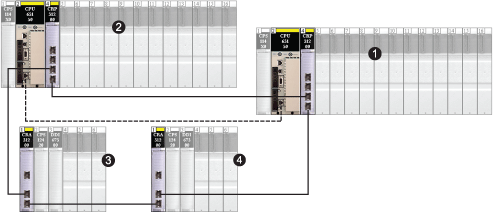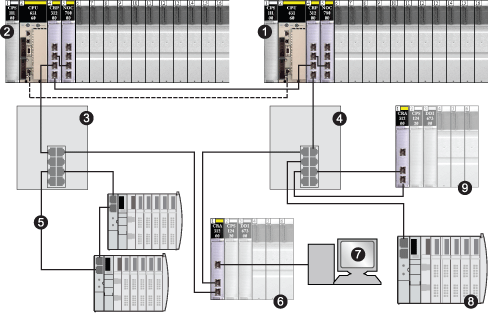|
Application Response Time Examples
|
|
|
Original instructions
|

1primary local rack
2secondary Hot Standby rack
3remote I/O drop daisy-chained on the remote I/O main ring
4remote I/O drop daisy-chained on the remote I/O main ring
|
Parameter
|
Maximum value (ms)
|
Comments
|
|---|---|---|
|
CRA drop process time (CRA_Drop_Process)
|
4.4
|
The sum of CRA input scan time and queue delay.
|
|
CRA input RPI (RPI)
|
–
|
User defined. Default = 0.5 * CPU period.
|
|
network input time (Network_In_Time)
|
(0.078 * 4) = 0.312
|
Hop-count is 4 from the CRA in remote I/O drop (4) to the CRP in local rack (1), which includes the switches in both the CRA and the CRP.
|
|
network input jitter (Network_In_Jitter)
|
(0.078 * 2) = 0.156
|
For delay occasioned by devices (2) and (3).
|
|
CRP input jitter (CRP_In_Jitter)
|
0.6 + (3 * 0.2) = 1.2
|
To read packet and forward it to the CPU.
|
|
CPU scan time (CPU_Scan)
|
–
|
User defined, based on application.
|
|
CRP output jitter (CRP_Out_Jitter)
|
1.6
|
CRP internal queue delay.
|
|
network output time (Network_Out_Time)
|
(0.078 * 4) = 0.312
|
Hop-count is 4 from the CRA in remote I/O drop (4) to the CRP in local rack (1), which includes the switches in both the CRA and the CRP.
|
|
network output jitter (Network_Out_Jitter)
|
0
|
Does not apply. No distributed I/O devices are connected to the remote I/O network.
|
|
CRA drop process time (CRA_Drop_Process)
|
4.4
|
The sum of CRA output scan time and queue delay.
|
|
For an explanation of each parameter, refer to the ART Computation Parameters topic.
|
||

1primary local rack
2secondary Hot Standby rack
3DRS on the remote I/O main ring
4DRS on the remote I/O main ring
5distributed I/O sub-ring with 2 distributed I/O drops
6remote I/O drop daisy-chained on the remote I/O main ring
7HMI device off the remote I/O drop
8distributed I/O device (cloud)
9remote I/O drop with 140CRA31200 adapter module
|
Parameter
|
Maximum value (ms)
|
Comments
|
|---|---|---|
|
CRA drop process time (CRA_Drop_Process)
|
4.4
|
The sum of CRA input scan time and queue delay.
|
|
CRA input RPI (RPI)
|
–
|
User defined. Default = 0.5 * CPU period.
|
|
network input time (Network_In_Time)
|
(0.078 * 6) = 0.39
|
Hop-count is 6 from the CRA in remote I/O drop (9) to the CRP in local rack (1), which includes the switches in both the CRA and the CRP.
|
|
network input jitter (Network_In_Jitter)
|
((0.078 * 2) +
(0.128 * 4)) = 0.668
|
2 remote I/O packets from devices (6) and (2) plus
3 distributed I/O packets from distributed I/O devices at locations (5), (8) and (1)
|
|
CRP input jitter (CRP_In_Jitter)
|
(0.6 + (2 * 0.2)) = 1.2
|
To read and forward packets from devices (9) and (6).
|
|
CPU scan time (CPU_Scan)
|
–
|
User defined, based on application.
|
|
CRP output jitter (CRP_Out_Jitter)
|
1.6
|
CRP internal queue delay.
|
|
network output time (Network_Out_Time)
|
(0.078 * 6) = 0.39
|
Hop-count is 6 from the CRA in remote I/O drop (9) to the CRP in local rack (1), which includes the switches in both the CRA and the CRP.
|
|
network output jitter (Network_Out_Jitter)
|
(0.128 * 4) = 0.512
|
Worst case, for devices (4), (6), (3), (2), and (1).
|
|
CRA drop process time (CRA_Drop_Process)
|
4.4
|
The sum of CRA output scan time and queue delay.
|
|
For an explanation of each parameter, refer to the topic ART Computation Parameters.
|
||